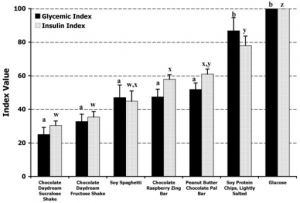The Skinny
Average Weight Loss: Varies, 1-2 lbs. per week
Type of Diet: Low-glycemic
About The Diet
 All carbohydrates have a glycemic index (GI). The GI of a food is a numerical value that you can use to determine how fast carbohydrates-containing foods will raise your blood sugar. The higher the GI on a food, the faster it is converted to glucose and enters the blood stream.
All carbohydrates have a glycemic index (GI). The GI of a food is a numerical value that you can use to determine how fast carbohydrates-containing foods will raise your blood sugar. The higher the GI on a food, the faster it is converted to glucose and enters the blood stream.
GI values in foods are often considered by people who need to watch their blood sugars (i.e. people with diabetes, insulin resistance, or who suffer from hypoglycemia.)
Foods that have a low GI enter the blood stream more slowly and are generally considered better for you, however, a food that is high in fat can have a lower GI and still be unhealthy. Cooking and how fresh fruit and vegetables are also can affect the GI of a particular food. For example, boiling noodles increases the GI value and overripe fruit has a higher GI value than fruit that is still in its peak.
How foods are processed also affects GI, for example, apples have a lower GI index than apple juice because the fiber has been removed and the juices broken down into sugar.
Below is a chart published by the National Institutes of Health the shows a few examples of GI values for soy products compared to glucose (sugar) (read full study):

Sponsored Ad
More Information
Negative Press
Positive Press
- Lowers risk of developing type 2 diabetes
- It can help suppress hunger
Health Concerns
Following a low-glycemic diet can be a balanced way to manage your weight, but be sure to check with your doctor before starting a diet and exercise program to make sure this is a safe diet for you.
** Provided for information only. This is not an ad but an excerpt from Amazon.com so you can read more about this book. **
The Glycemic-Load Diet: A powerful new program for losing weight and reversing insulin resistance
By Rob Thompson




